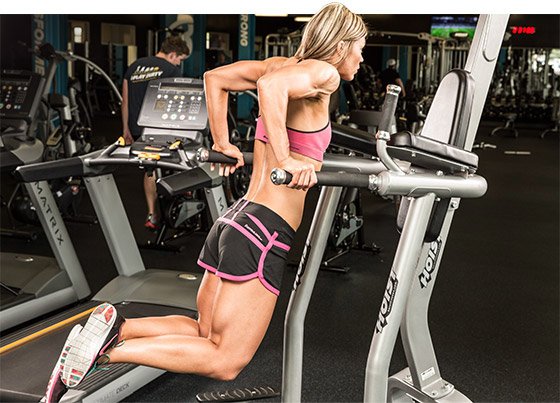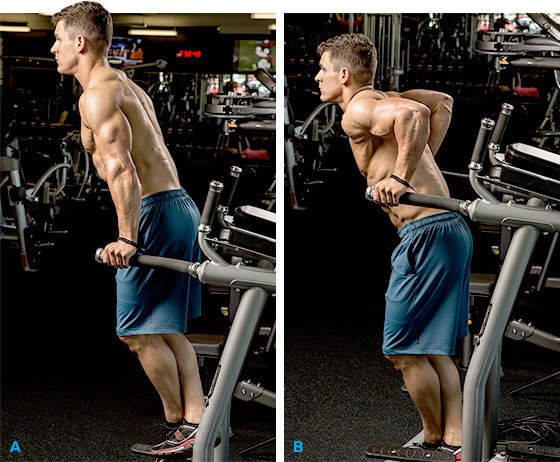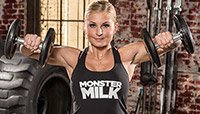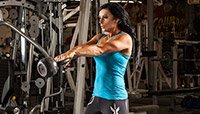You know you've had a great workout when you can't lift a weight even one more time. That's called concentric (positive) muscle failure. But while some may use positive muscle failure as a marker of success, that doesn't mean you're so fatigued you still can't lower that same weight under control. In fact, training with negatives—in which you lower a weight very slowly rather than lift it—has been proven to elicit gains in size and strength above and beyond what positive-rep training can do.
Training with negatives may be something you've tried in the past, most likely at the end of a set when your partner raises the weight and you slowly lower it. The fact is, you're typically stronger on the negative: It's easier to control the lowering of a heavy weight than it is to lift it.
That's why this monster finishing movement for chest targets the negative. The first exercises in your chest workout are done to concentric muscle failure, but this takes those same muscle fibers to eccentric muscle failure, meaning there's simply nothing left in the tank.
Chest-Day Massacre
A well-constructed chest workout includes presses and flyes from a variety of angles that target the different areas of your pecs: upper, middle, lower, inner, and outer. Clearly, what you do at the beginning of your workout, when your strength levels are high, goes a long way toward determining your eventual success in bringing up your pecs. But it's what you do at the end of your session that determines whether you generate the kind of mind-blowing pump that separates one workout above all the rest.

Here's a chest-day finisher that's guaranteed to make those deep fibers burn. The exercise of choice—the bodyweight dip—is a fairly innocuous one that's commonly done to target the lower pecs. For most bodybuilders, in fact, it's quite easy. Which is why you'll be doing it last in your chest workout; by then, your pecs will be highly fatigued.
The focus here is completely on the negative—you won't be doing a single positive rep. But the kicker is that you'll be taking a full 10 seconds—not a fast count—to lower yourself from the arms-extended position to the bottom. Of course, taking 10 seconds to complete the negative is much harder than what you normally do on dips, which is simply lower yourself under control.
To ensure that you do only negatives, after you lower yourself, put your foot on the footplate and use your legs to hop back up to the top position. Do not press through your pecs to go back up, because the intention of this technique is to focus just on the negative.
Do as many reps as you can in this manner, taking 10 seconds to lower yourself on each and every rep. By the sixth or seventh rep, you'll find it increasingly difficult to control your rate of descent, but it's important to slow yourself down as best you can. Continue with as many reps as possible.
End your set when you can no longer hold the negative for more than 4-5 seconds. Repeat two more times after a brief rest period and you'll see how negatives can bring about positive growth!
GET STARTED
Here are some tips to get more out of negative dips:
Jump up onto the parallel bars, holding your body with your arms extended and a neutral grip (palms facing in). Your arms should be straight but your elbows should never be locked out.
Cross your ankles and draw them up toward your glutes, which will push your center of gravity slightly forward so that you're now leaning slightly forward. This will help shift the emphasis from your triceps to your pecs.
Skip the weight belt unless you're very strong. By the end of your workout you should already be highly fatigued.
Lower yourself very slowly by allowing your arms to bend, ultimately to about 90 degrees. Allow your elbows to flare directly out to your sides. Pushing them out to your sides puts more emphasis on the pecs; in contrast, if you keep them tight to your sides, you shift some of the focus onto your triceps.

Dip
Count to 10 seconds as you fight to control the speed of the descent. As you fatigue, it becomes increasingly difficult to reach 10, but keep trying. A partner counting and encouraging you helps.
Because you're going so slowly, the muscle is still contracting, even though it's also being slightly stretched during the contraction. This is the eccentric contraction at work.
Once you hit bottom, don't press back up using your pecs. Since this technique focuses on the negative only, instead place your foot on the bar and use your leg strength to hop back up. That completely eliminates the positive rep.
As you fatigue, you'll start to descend at a faster rate. You may not be able to hold for 10 seconds, but keep going. Once you can no longer hold the negative for 4-5 seconds, terminate the set.

Recommended For You

Brittany Tacy's Sexy Shoulder Workout
Stately shoulders are the key to any well-rounded physique. Build sculpted shoulders with this workout from IFBB bikini pro Brittany Tacy.
5 Ingredients For The Perfect Fat-Loss Circuit
Too often, metabolic circuits are little more than a mess of randomly paired movements. Here's the formula for a precise fat-loss workout!
